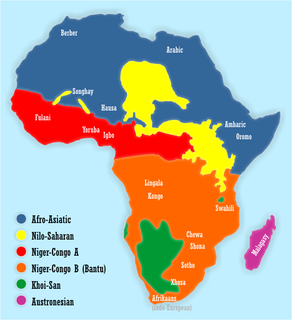| Dengese | |
|---|---|
| Native to | Democratic Republic of the Congo |
| Region | Northern Kasai Oriental Province |
Native speakers | 8,600 (2000) [1] |
| Language codes | |
| ISO 639-3 | dez |
| Glottolog | deng1250 [2] |
C.81 [3] | |
Dengese (Lengese, Ndengese) is a Bantu language of northern Kasai-Oriental Province, Democratic Republic of the Congo.

The Bantu languages technically the Narrow Bantu languages, as opposed to "Wide Bantu", a loosely defined categorization which includes other "Bantoid" languages, are a large family of languages spoken by the Bantu peoples throughout Sub-Saharan Africa.

Kasai-Oriental is one of the 26 provinces of the Democratic Republic of the Congo. Specified under Article 2 of the country's 2006 Constitution, the new province was finally created in 2015 from Tshilenge District and the independently administered city of Mbuji-Mayi, both part of the larger, pre-2015 Kasai-Oriental province. The new province's territory corresponds to the historic Sud-Kasaï province that existed in the early period of post-colonial Democratic Republic of the Congo between 1963 and 1966.

The Democratic Republic of the Congo, also known as DR Congo, the DRC, DROC, Congo-Kinshasa, or simply the Congo, is a country located in Central Africa. It is sometimes anachronistically referred to by its former name of Zaire, which was its official name between 1971 and 1997. It is, by area, the largest country in Sub-Saharan Africa, the second-largest in all of Africa, and the 11th-largest in the world. With a population of over 78 million, the Democratic Republic of the Congo is the most populated officially Francophone country, the fourth-most-populated country in Africa, and the 16th-most-populated country in the world.


